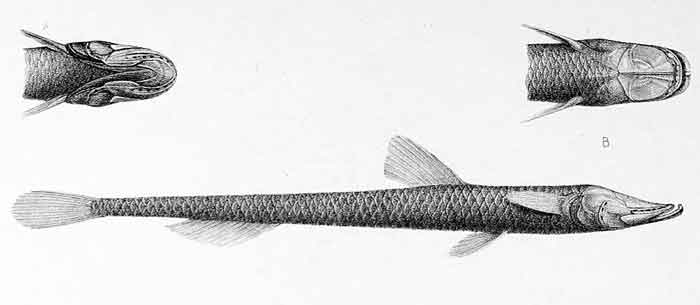Superregnum: Eukaryota
Cladus: Unikonta
Cladus: Opisthokonta
Cladus: Holozoa
Regnum: Animalia
Subregnum: Eumetazoa
Cladus: Bilateria
Cladus: Nephrozoa
Superphylum: Deuterostomia
Phylum: Chordata
Subphylum: Vertebrata
Infraphylum: Gnathostomata
Megaclassis: Osteichthyes
Superclassis/Classis: Actinopterygii
Classis/Subclassis: Actinopteri
Subclassis/Infraclassis: Neopterygii
Infraclassis: Teleostei
Megacohors: Osteoglossocephalai
Supercohors: Clupeocephala
Cohors: Euteleosteomorpha
Subcohors: Neoteleostei
Infracohors: Eurypterygia
Section: Aulopa
Ordo: Aulopiformes
Subordo: Chlorophthalmoidei
Familia: Ipnopidae
Genus: Ipnops
Species: I. agassizii – I. meadi – I. murrayi
Name
Ipnops Günther, 1878
References
Günther, A. (1878) Preliminary notices of deep-sea fishes collected during the voyage of H. M. S. `Challenger.'. Annals and Magazine of Natural History.
Ipnops – Taxon details on Integrated Taxonomic Information System (ITIS).

Ipnops murrayi
Ipnops is a genus of deep-sea fish in the family Ipnopidae, which also includes the better-known tripodfish (Bathypterois grallator). Ipnops are small, slender fish that live close to the ocean floor in the bathyal and abyssal zones. The genus is notable for its unusual eyes.
Species
There are currently three recognized species in this genus:[1]
Ipnops agassizii Garman, 1899 (grideye fish)
Ipnops meadi J. G. Nielsen, 1966
Ipnops murrayi Günther, 1878
Distribution
Specimens of I. murrayi and I. agassizi have been caught at depths of 1392–3475 m; I. murrayi occurs in the Atlantic Ocean while I. agassizi occurs in the Indo-Pacific region. I. meadi is also found in the Indo-Pacific, but occurs deeper at 3310–4970 m.
Biology
Ipnops has only recently been observed in the wild, so details of their life history has mostly been inferred from the characteristics of captured specimens. They have large mouths with numerous small teeth for swallowing large prey, as well as well-developed gill rakers for capturing smaller items. Examination of stomach contents show a diet of mostly crustaceans and polychaete worms. Their eyes are extremely modified into flat, cornea-like organs that cover most of the upper surface of the head.
The purpose of these structures is debated—they are light-sensitive and may serve to detect bioluminescent prey; it has also been proposed that the organs themselves may be luminescent and act as lures. Ipnops have a well-developed lateral line, which has been suggested to have a primary sensory function given the degenerate state of their other senses.
Like other bathypteroid fishes, Ipnops is hermaphroditic, with male and female gonads combined into a single organ. External fertilization is likely, possibly with ripe eggs held by the pelvic fins to facilitate fertilization. The capture of multiple specimens in single trawls suggests that these fishes may live in aggregates.
References
Froese, Rainer; Pauly, Daniel (eds.). "Species in genus Ipnops". FishBase. April 2012 version.
Bibliography
Ellis, Richard (1996). Deep Atlantic: Life, Death, and Exploration in the Abyss. New York, NY: The Lyons Press. ISBN 1-55821-663-4.
Nielsen, Jørgen G. (1966). "Synopsis of the Ipnopidae (Pisces, Iniomi) with descriptions of two new abyssal species" (PDF). Galathea Rep. 8: 49–79. Archived from the original (PDF) on 2007-06-10. Retrieved 2008-10-08.
Retrieved from "http://en.wikipedia.org/"
All text is available under the terms of the GNU Free Documentation License

